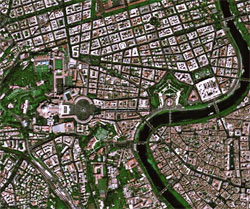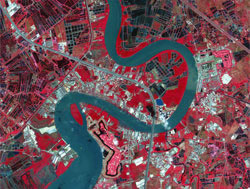Description
High resolution optical imagers provide detailed images of the Earth’s surface. In general, these are nadir-viewing instruments with a horizontal spatial resolution in the range 10 to 100m, and swath widths of order 100km. In the past few years, high resolution sensors have emerged with spatial resolution in the range 1-5m. An increasing number of government-funded and private sector-funded sensors with sub-5m resolution are planned for the coming years.
High resolution imagers are, in general, panchromatic and multispectral sensors with spectral bands in the visible and IR range, which are simultaneously recorded. This increases the information content that may be derived from the imagery (including the ability for land cover classification) and allows corrections to be made, for example, for the effects of atmospheric water vapour on the measured surface parameters. In order to reduce atmospheric absorption and to increase image quality, the operating wavelengths of these instruments are selected to coincide with atmospheric windows.
Use of these sensors can be limited by weather conditions, since they are unable to penetrate thick cloud, rain or fog – typically being restricted to fair weather, daytime-only operation. Some have pointing capability which enables imagery of specified areas to be acquired more frequently.
Many countries, including developing countries, have and/or are planning high resolution optical imaging programmes. Future trends will include a greater number of sampling channels, and improved spectral and spatial resolution. More instruments will also become available that are capable of producing stereo images from data collected on a single orbit, ie along track, as opposed to across track whereby stereo images are acquired from different passes.
Applications
High resolution optical imagers are amongst the most widely applied of Earth observation satellite instruments, finding application in, for example:
- agriculture: definition of crop type and area, Crop inventory, yield prediction;
- natural hazards: damage assessment;
- geological mapping;
- urban planning: land cover mapping; topographic mapping; urban development monitoring;
- cartography: map generation and updating; generation of digital elevation models;
- environmental planning and monitoring.
 SPOT 5 launched in May 2002 features imaging sensors with 2.5m resolution. This image is of Rome. |
 A town in Thailand imaged by the LISS IV sensor on ISRO’s Resourcesat-1 |
| Current & planned instruments ALI ASTER AVNIR-2 AWiFS CCD (CBERS) CCD (HJ, HY) DMC Imager EOC ETM+ HRG HR-PAN HRS HRTC HRV HRVIR IR-MSS IRS LISS-III LISS-IV MBEI MIREI MSC MSI MSS MSU-EU PAN PAN (Cartosat-1) PAN (GISTDA) Pleiades HR PRISM TM TOPSAT telescope WFI |
| ALOS (AVNIR-2 & PRISM): www.jaxa.jp/missions/projects/sat/eos/alos/index_e.html SPOT: www.spotimage.fr Landsat: landsat.usgs.gov CBERS: www.cbers.inpe.br/en/index_en.htm TOPSAT: www.qinetiq.com/home/case_studies/security/security2.html |